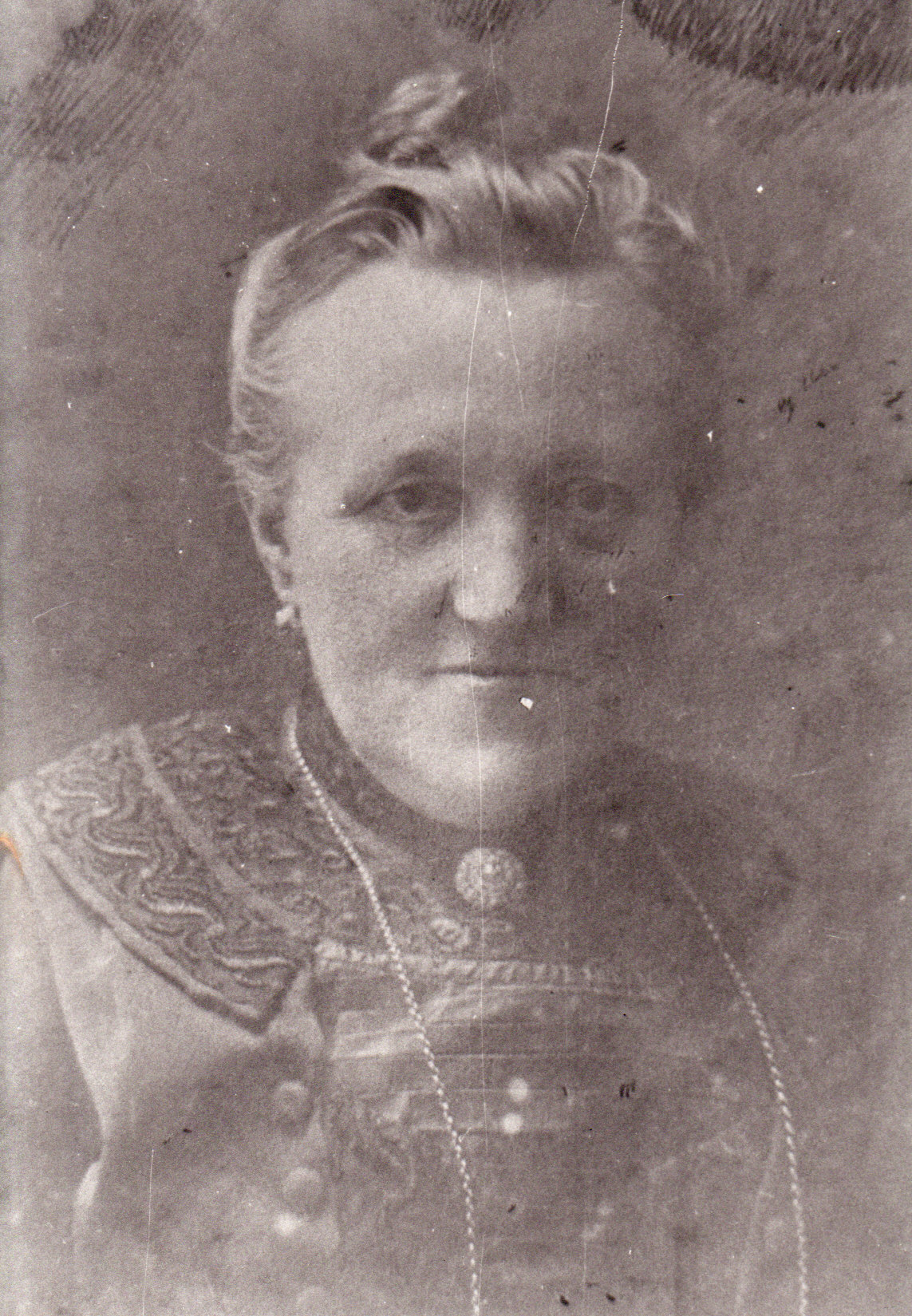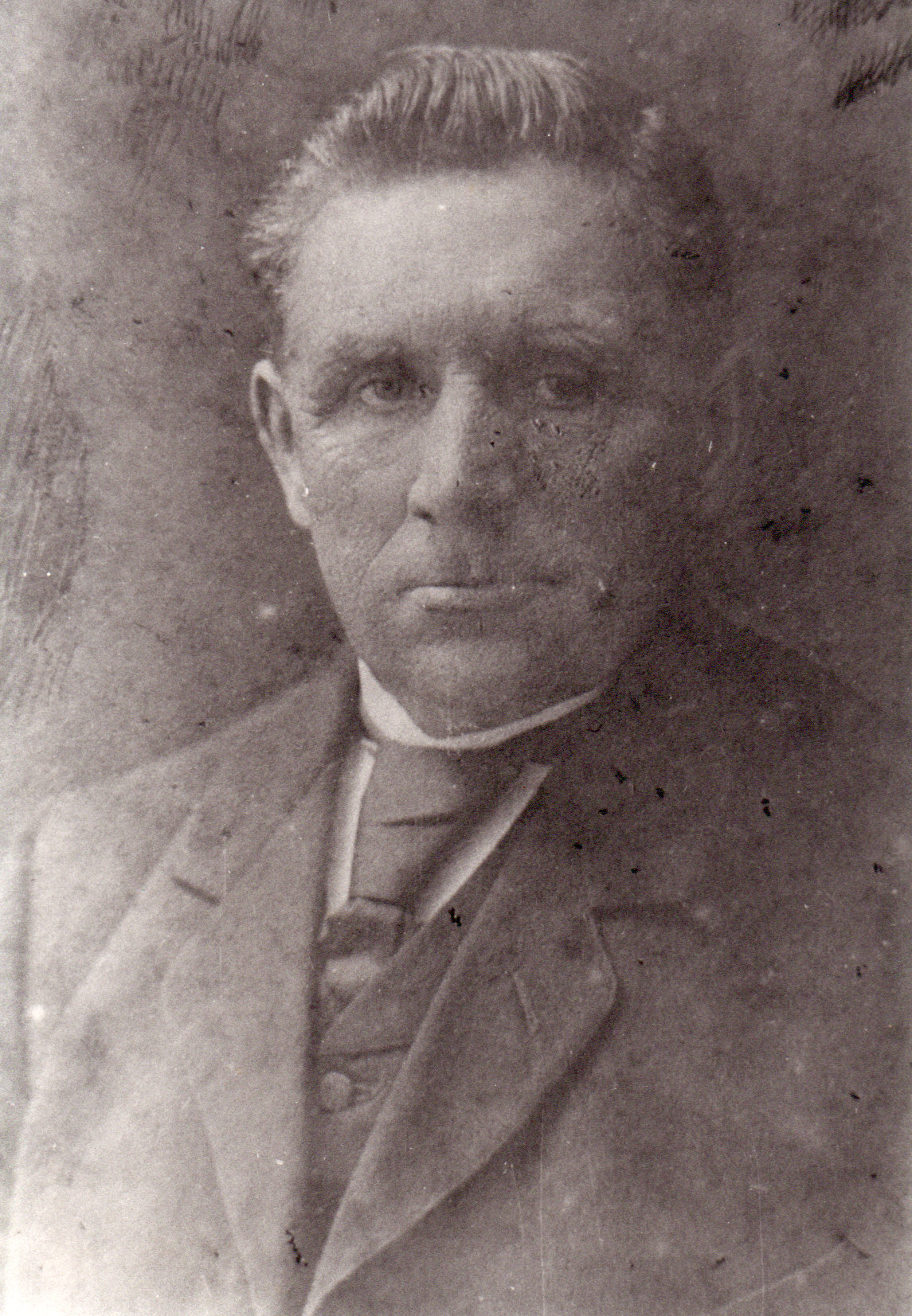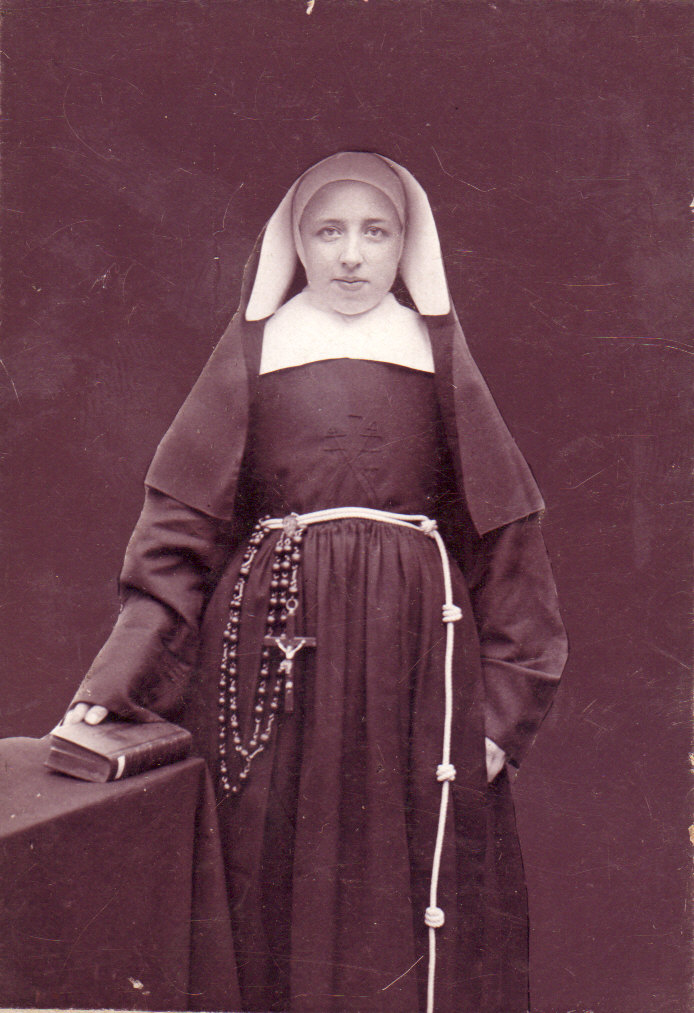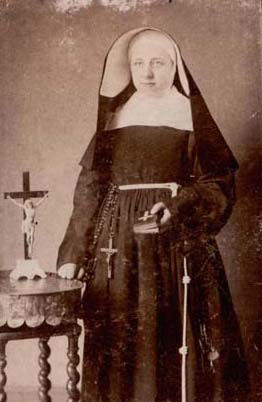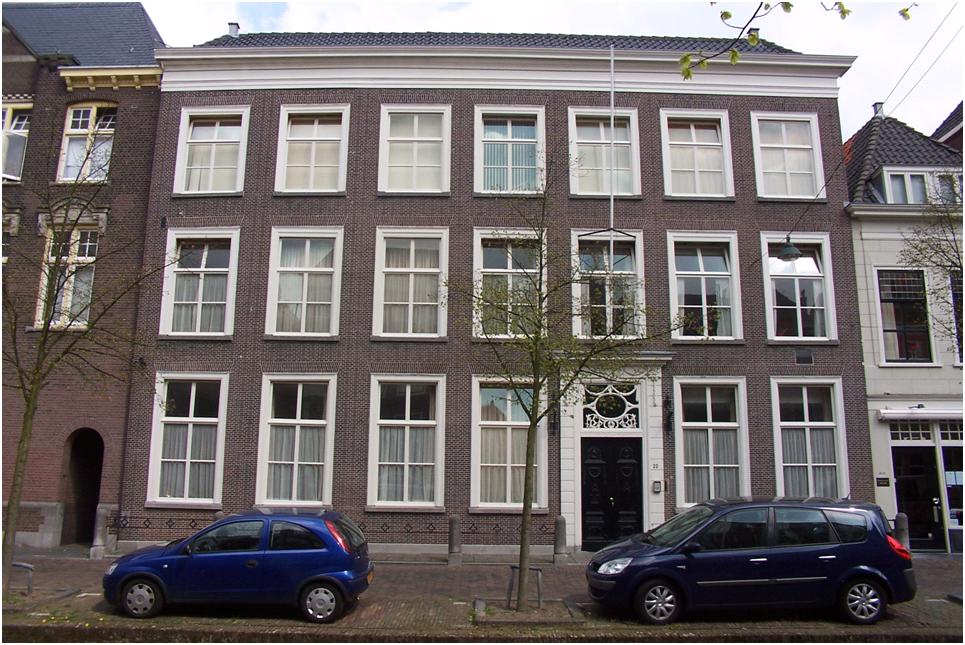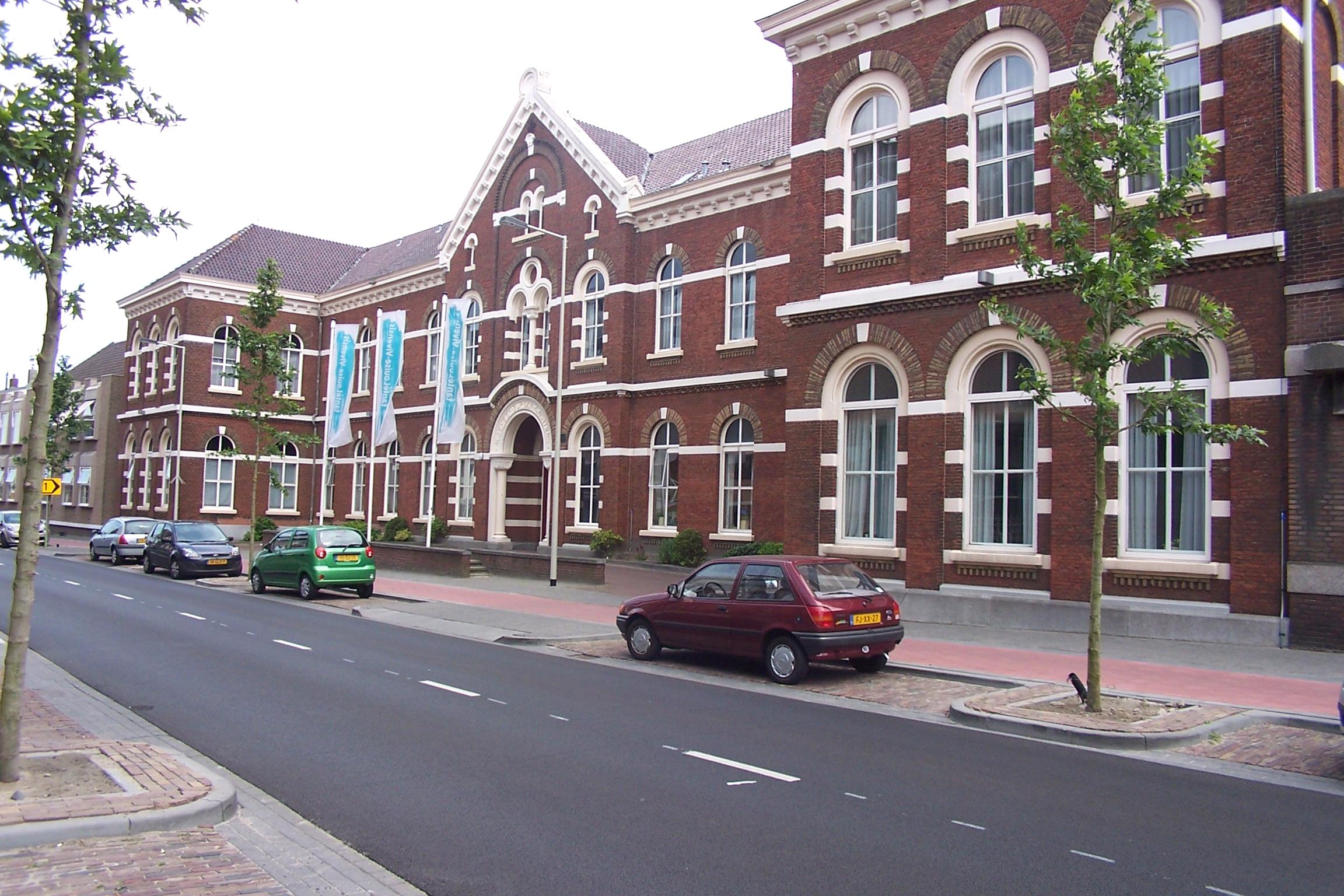Leeuwendeel
"Van Leeuwen" in de familie? / "Van Leeuwen" in the family?
Sister Maria Hildegarda 1886-1944
Catharina Maria van Leeuwen (1857-1936) |
On 12 May 1886, Catharina Maria (Ca) van Leeuwen born in Delft as second child of the family. She is the first daughter of Willebrordus Gerardus van Leeuwen and Mary Cornelia (Kee) Meijer.
She grows up in a family with eleven children. Maybe there are twelve childeren, but one of the children doesn't survive the birth. Four of the other children also die very young age. Although at that time it is quite normal for children to die young, undoubtedly her parents have a lot of grief. Also Ca will mourn them. The religious experience is very different at that time. God is felt to be present at all events in life. Thus it is possible that Ca feels called to become a nun for life in services to God in gratitude that she had servived. But that of course is speculation. The sisters don't talk about thos things. Maybe mother superior, or confessor to hear about it, but she has never written down such private matters.
Probably Ca goes to Roosendaal in 1904 in order to enter the Congregation of the Franciscan Sisters Penitents Recollectinen Roosendaal. From that moment she is considered a religious person. Then the period of accustoming begins, which is called "postulate".
On 17 September 1905 Ca receive her nun's clothes. At that stage her real education to become a religious person begins. On that occasion she receive the monastic habit with a white veil. On that day she receive her religious name "Soeur Marie Hildegarda of the Immaculate Conception". Until today she's registered under this name. But she's called as sister Hildegarda. For her siblings she remains Ca.
Catharina Maria van Leeuwen (1857-1936) |
Profession
Only when you do your "profession", by pronouncing three vows, you became an official member of the congregation. Prior to this you have to make a will that after death no possessions sould to be claimed. Only any usufruct of real property are to be given to the congregation.
Ca lets Johannes Josephus Maria Mertens sign that will on 24 August 1907. He's a Notary Public in the district of Breda, based in Roosendaal. It's there where Ca proposes a new testament, which replace earlier testaments. She appoints the "Society of Education in Roosendaal" as her sole and full heir. This is a public organisation with the aim to build and operate boarding schools for the Congregation of the Franciscan Sisters Penitents Recollectinen Roosendaal. This association looks after all business interests of the congregation and its members, including wills. When signing the will two witnesses are present. One is the 26-year-old candidate notary Hippolith Marie Joseph Verheggen who was born in Sittard. The other is the 54-year-old gardener Peter van Rijn who was born in Monster.
Two years later, on 17 September 1907, Sister Hildegarda makes her three vows: obedience, poverty and purity. Her white veil is replaced by a black one, she get a long scapular and a white cord with three knots in it to symbolize the three vows. After making the three vows Sister Hildegarda became an official member of the congregation.
Presently (in 2009) most of the sisters do not wear these clothes anymore. During 1966-1970 the Pastoral Council decided that sisters may wear civilian clothes in the Netherlands, although this was against the wishes of Pope Paulus VI.
Voorstraat 22 in Delft on 19 April 2009 |
Antoniusschool
As apostolate work has this Congregation upbringing and education of children.
This Congregation take care of the upbringing and education of children. After of your vows you normally are sent to a "succursaal" house somewhere in the Netherlands. Sister Hildegarda is sent to Delft. She settled down in the St. Anthony's Monastery in Voorstraat 22. This monastery is a large representative house which is bought by the church council in 1872 and has to serve as a convent for the Sisters of Roosendaal.
In 1876 it also became a Catholic school for poor girls. The school is named Anthony School. This school is so popular that in 1914 even 196 new students are accepted. What sister Hildegarda's job at the Anthony's School is, is not clear to me, but by all accounts she is a teacher and one of her pupils is her younger sister Marie. Marie doesn't like to have her sister as her teacher, because she feels she always has to behave herself.
|
|
General Hospital for Citizens in Bergen op Zoom.
|
Hospital in Bergen op Zoom
On 30 December 1918 sister Hildegarda moves to the city of Bergen op Zoom to the Public Hospital for Common Citizens. This hospital already appeare in writings of the Middle Ages in 1246. At that time the building was on the territory of the city of Breda. It seems that this place was important enough to build a hospital. Now this place is on the territory of Bergen op Zoom. About Hillegarda's time there only little is known. Also only few historical facts about the period from 1400 onwards. We do know that various alterations and extensions to the building took place. Aslo we know that big pieces of land belonged to this hospital.
When the city wall was built in Bergen op Zoom the hospital was within the walls. Usually a hospital was built on the outskirts of a city and preferably at an access road to that area. This also was a landmark
for the location of other buildings or to indicate a route.
The hospital has had several names. "Hospital of Bergen", "Old Hospital", "General Hospital for Citizens", "St. Elisabeth Hospital" and "St. Catherine Hospital." The hospital has had several buildings, but the job of the hospital has remained virtually unchanged. Taking care of sick and injured people has been the most important task, but it also serve as an asylum and poor citizens were allowed in. The hospital building now is not the same building of the hospital in 1246. Approximately in 1582 the hospital was demolished and patients were moved to another almost empty hospital. Now in 2009 there are talks about the possible demolition of that hospital building.
Possibly Sister Hildegarda is ill, because the Sisters normally don't live in a hospital. Perhaps she hopes to return to Delft, because only on 27 January 1919 she registers herself at the city council of Bergen op Zoom. According to the entries there, she is registered as a teacher.
Mother dies
On 3 April 1921 her mother dies in Delft. Ca cann't or is not allowed to come to the funeral, but she writes a Dutch letter on lined paper out of a notebook. At the top of each letter she writes are the letters "JMJF", referring to "Jesus, Mary, Joseph, Franciscus".
Dear Father, dear brothers and sisters.
Last Sunday on the phone, I thought to understand that the funeral will be on Wednesday at 8 o'clock, then I heard no further, but I think it's 8 o'clock, half past eight and ten o'clock Holy Masses will be. I accept it.
I believe, dear Father, that our dear Mother is in heaven already and that she is a powerful intercessor for us at the throne of God, but for you and us it is a great sacrifice to miss our beloved Mother, not being able to see and speak her anymore.
I can imagine how it will be tonight, how all of us but especially Joris and Anna will miss our dear Mother. I would like to come to you to tomorrow so much, to see my dear unforgettable Mother for the very last time.
After the Holy Communion which I wish to bring peace to the soul of my mother, I brought Jesus the sacrifice again, my mother had brought the sacrifice to Jesus before, now I could bring the sacrifice of my beloved Mother.
The corpse of my dear Mother will be taken to the grave soon, I'm not going there in spirit, but when I would like to see my mother and talk to her in future I will look for her in heaven.
May I thank Joris first, that he helps Father so much.
Everything helps and especially the letters and the card which I received last week. Of course I pray for my father, brothers and sisters, but Joris can count on an extra Holy Mary prayer, because he wrote to me about what happened as soon as possible.
Our Venerable Sister Luperieuze was in the church last Sunday afternoon with the first holy communion of some children. I had written a postcard to ask for prayers for my deceased Mother. Sister Luperieuze came out of the church to condole with my mother and she blessed me, that the Sisters dedicate the Holy Communion to the soul of my dear Mother and on Monday morning they would pray the vigil of the deceased. Also here in the hospital the Reverend Mother and Sisters pray for my mother. Joris, this week I will get a message from
you, or from Marietje or Anna, won't I.After once again expressing my sympathy, dear Father, brothers and sisters, I remain,
Your loving child and him, sister
Sister Marie Hildegarda.
B.o.Z. So. 5 April 1921
Illness?
It is not clear if she is ill in Bergen op Zoom during the whole period there and also whether she feels well enough to move again. But on 12 September 1921 she moves to Roosendaal. She'll live in the mother monastery Ste. Marie, Molenstraat 13. Probably after she became even more sick she moves to another monastery in Wouwscheweg 3.
This monastery was built in 1927 especially to take care of the sick and/or elderly sisters.
|
|
Mariadal in Roosendaal anno 2009 |
The structure of the congregation is as follows: the Mother House Ste. Marie is located in Roosendaal. Since 1934 there is a new monastery called "Marian". It is located in Vincentiusstraat 7, Roosendaal. The Congregation is run by five sisters of the Mother House and has many "branch houses" in that time, subordinate to the Mother House.
The distance between Delft and Roosendaal is too far for a daily visit by bike. Yet it is known in the family, that one or more family members visit Sister Hildegarda occasionally. Marie Bol and her
godchild Corry Vieveen, who was about 8 or 9 years old at that time, have visited her once. They had lemonade in a sterile room.
On 23 January 1926 Ca writes a letter from Roosendaal to one of her sisters. Also this time she uses a sheet from a notebook. She writes
the following:
Dear Sister,
I would feel so sorry if you did not get this letter tomorrow, the whole week I couldn't write, every time when I wanted to write there was something else.
From four to five o'clock I was praying it's nocturnal Adoration, now at half past five I can talk to you, even though it's with a pen.
Congratulations, Aunt Mary, with your birthday, I hope that you may often remember this day in good health.
Therefore I pray especially during my Adoration Hour, I've prayed O.D.L. for all my loved ones and for Cornelis and you I asked for God's blessing on your work and your garden, because digging and planting is already very much, but the water has to come from above.
You too, dear brothers-in-law, I congratulate you with your wife's birthday. How is Jaantje doing? Is she still a half pound heavier every week? You'll surely get a lot of visitors because the birthday is on Sunday, Marie was born on Saturday night, I can still remember everything well. Father had a bad cold and Aad went to bed early. I had to call Grandma, because mother did not feel well. Now you are a mother yourself, I can't believe I'm almost forty myself already.
Last Wednesday I went to Leiden with a child, passing Delft in the morning. In Leiden I took the train at 4.39 hours which had a little stop in Delft, but because I didn't know beforehand that I had to wait at the doctor's for so long, I would have gone home earlier, otherwise I would have informed Anna. You will pass my kind regards on to father and all siblings for sure. have warm greetings from me, certainly. After greeting you, dear sister and brother-in-law, also aunt Ploon, uncle Hendrik, aunt Co and uncle Bertus, who may be also will visit you and have, I remain,
Your loving sister
Zr.Marie Hildegarde
On 30 November 1936 her father dies in Delft.
Her brother Wim and another family member visit Ca in Roosendaal during the war. They go by train. During the trip the train is attacked by aircraft. Fortunately they survive this trip.
Parkinson
At the end of her life Sister Hildegarda is suffering from the disease called "paralysis agitans". This illness is better known under the name "Parkinson" and is characterized by disturbances in movement of which trembling of fingers and hands perhaps is best known. But also dementia can be a part of this disease. In 2009 1.4% of the population aged 55 and older is suffering under the Parkinson disease. Elderly people aged between 85 and 95 years 4 out of 100 suffer under this disease. This is much more than was assumed until recently. The disease is often not recognized as such particularly among the oldest group of people. About 10% of the patients already get it below 40 years of age. The cause of the uncontrolled movements appear to be due to the loss of cells in the brain. Until today this disease cannot be cured. However, the symptoms can be stopped temporarily, with the help of medicine. Usually people don't die from this disease, but e.g. because of the effects of infections.
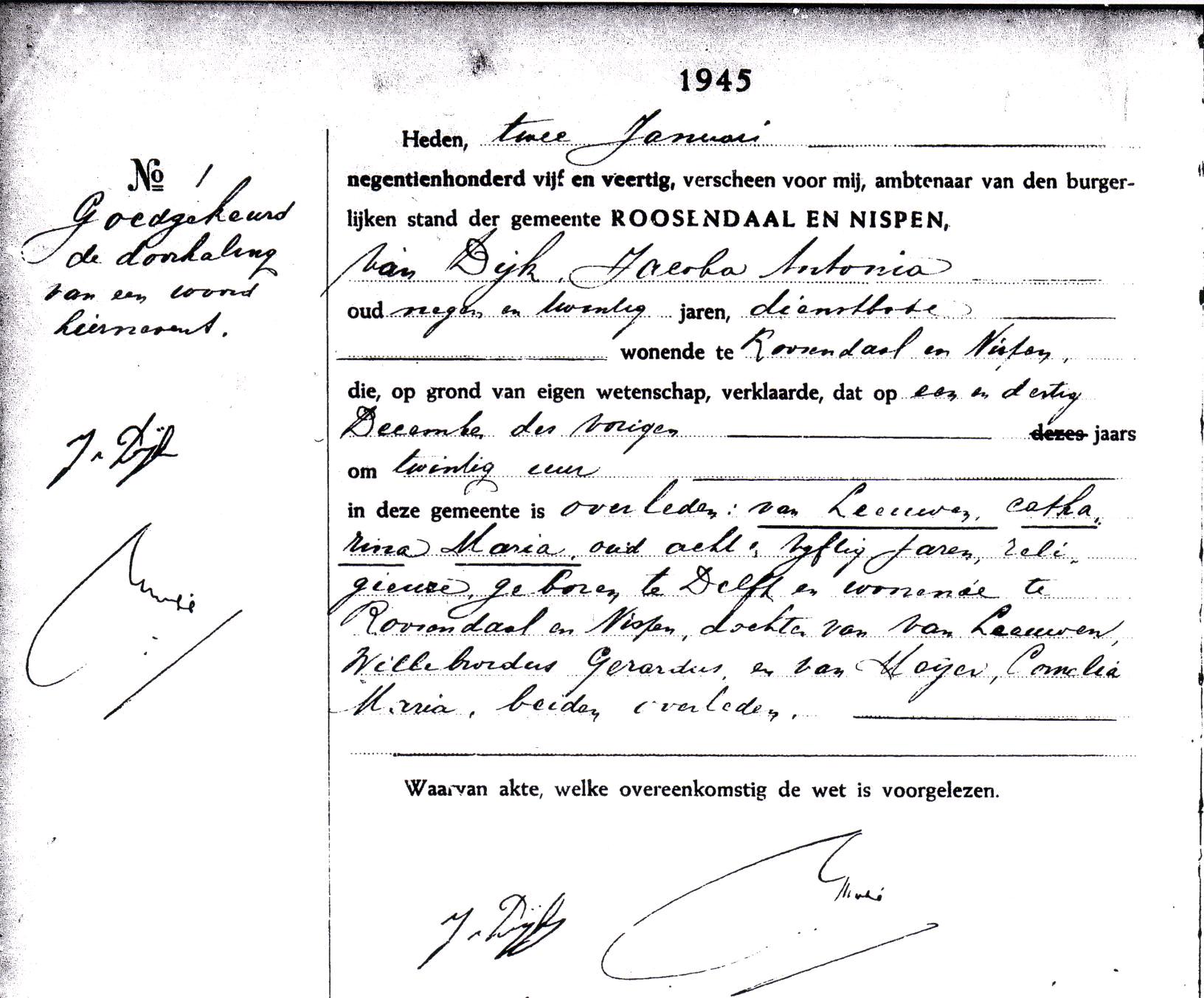 |
Overlijdensakte nr. 1 1945 to Roosendaal en Nispen |
On the basis of personal knowledge the 29 year old maid Jacoba Antonia van Dijk, who also lives in Roosendaal and Nispen, certifies on 2 January 1945 that Catharina Maria van Leeuwen died on 31 December 1944 at 8 o'clock p.m. In the mortuary card we read that she had been ill for a long time, after which she was released from her sufferings at the age of 58 by God in the monastery of St. Elizabeth in Roosendaal and Nispen.
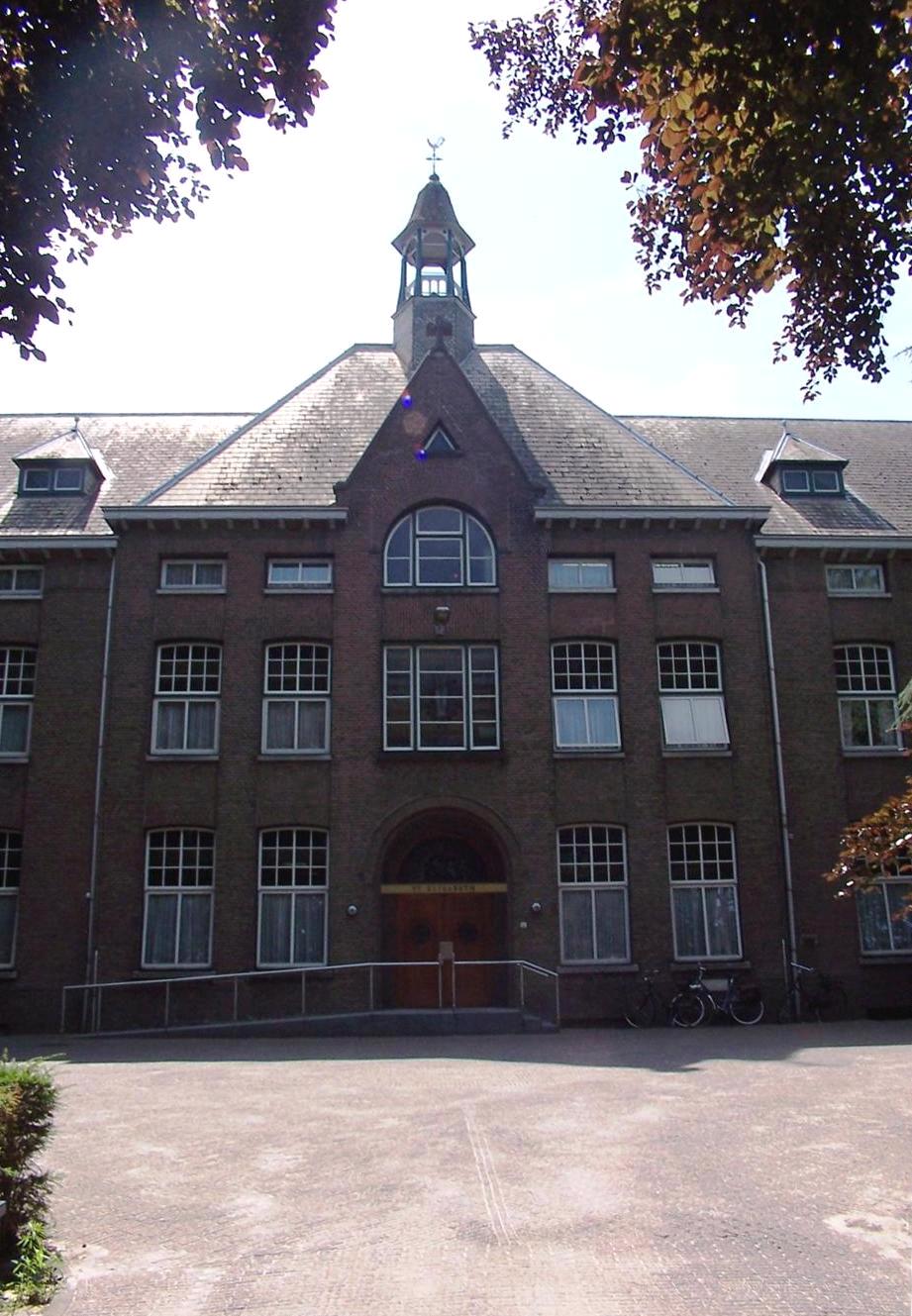 |
St. Elisabeth monastry.
|
Unfortunately this news doesn't reach the family. Only after the war her brother Wim is the first one to hear that she died, when he wanted to visit her by bike. The distance is no problem for him. He is used to cycle long distances, like many other people. But after arriving there, he is told that she died. It must be a big shock for the whole family to hear this.
St. Elisabeth monastery was founded in 1927 as a home for nuns belonging to the Congregation of Franciscan Sisters Mariadal. In the late seventies, the monastery became a private social welfare institution in order to take care of the sisters in the congregation. Since 2000 St. Elisabeth is also open to non-religious people.
Every year she is still commemorated in the Mariadal Convent in Roosendaal, like all other deceased sisters. It has always been the habit to write a piece of text "In Memoriam" of every deceased sister for the congregation newsletter. But during the very last months of 1944 and beginning of 1945 apparently little or no communication is possible. If it were written, we may be would have received an even better impression of sister Hildegarda.
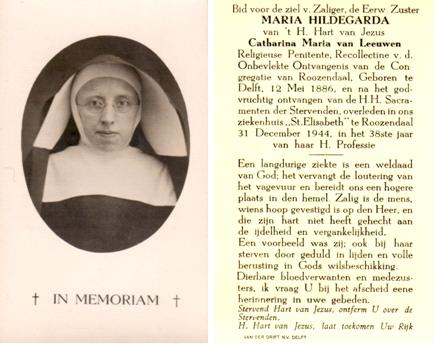 |
The front and backside of the mortuary card of
|
